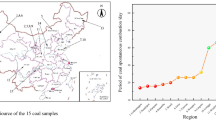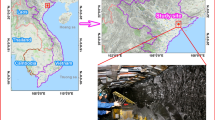Abstract
Coal combustion is one of the main sources of mercury emission. Studies using artificial neural networks (ANNs) to predict mercury emission have shown the feasibility of ANN method. Such analyses aimed to provide guidance for mercury emission control in coal combustion. A mercury emission prediction model was developed by modifying the traditional back propagation (BP) neural networks, and a genetic algorithm (GA) based on global search was used, so called the GA-BP neural networks. In total, six main factors were evaluated and selected as the characteristics parameters. Totally, 20 coal-fired boilers were used as training samples, and three different types of mercury including elemental mercury, oxidized mercury, and particulate mercury were used as outputs. The accuracy of prediction results was analyzed, and source of error was discussed. Results show that correlation efficiency for the training samples was as high as 0.895. Three additional samples were studied to test the predictive model. Results of training and predicting were highly correlated with actual measurement results. It is shown that GA-BP is a promising model for mercury speciation prediction.








Similar content being viewed by others
References
Abdel-Aal RE (2007) Predictive modeling of mercury speciation in combustion flue gases using GMDH-based abductive networks. Fuel Process Technol 88:483–491
Francis NK, Luther A, Salib E, Allanby L, Messenger D, Allison AS, Smart NJ, Ockrim JB (2015) The use of artificial neural networks to predict delayed discharge and readmission in enhanced recovery following laparoscopic colorectal cancer surgery. Tech Coloproctol 19:419–428
Kashani MN, Shahhosseini JAM, Farrokhi M (2012) Dynamic crude oil fouling prediction in industrial preheaters using optimized ANN based moving window technique. Chem Eng Res Des 90:938–949
Kawashima M (1994) Artificial neural network back propagation model with three-phase annealing developed for the building energy predictor shootout. ASHRAE Trans 100:1096–1118
Lau GK, Du H, Lim MK (2011) Use of functional specifications as objective functions in topological optimization of compliant mechanism. Comput Methods Appl Mech Eng 190:4421–4433
Pudasainee D, Kim JH, Yoon YS, Seo YC (2012) Oxidation, reemission and mass distribution of mercury in bituminous coal-fired power plants with SCR, CS-ESP and wet FGD. Fuel 93:312–318
Qeethara AS, Ghaleb ER (2013) Predicting the effects of medical waste in the environment using artificial neural networks: a case study. Int J Comput Sci Issues 10:258–261
Robert RJ, Shankar K, Hossein S (2004) Artificial neural network-based estimation of mercury speciation in combustion flue gases. Fuel Process Technol 85:451–462
Saman N, Johari K, Mat H (2015) Removal of elemental mercury from gas stream using sulfur-functionalized silica microspheres (S-SMs). Clean Technol Environ Policy 17:39–47
Tang N, Pan SW (2013) Study on mercury emission and migration from large-scale pulverized coal fired boilers. J Fuel Chem Technol 41:484–490
Ticknor JL, Hsu-Kim H, Deshusses MA (2014) A robust framework to predict mercury speciation in combustion flue gases. J Hazard Mater 264:380–385
Villers J (1992) Back-propagation neural nets with one and two hidden layers. IEEE Trans Neural Netw 4:136–146
Wang SX, Zhang L, Li GH, Wu Y, Hao JM, Pirrone N, Sprovieri F, Ancora MP (2010) Mercury emission and speciation of coal-fired power plants in China. Atmos Chem Phys 10:1183–1192
Wang Y, Li B, Weise T, Wang JY, Yuan B, Tian QJ (2011) Self-adaptive learning based particle swarm optimization. Inf Sci 181:4515–4538
Xu CQ, Hong JL, Ren YX, Yuan XL (2015) Approaches for controlling air pollutants and their environmental impacts generated from coal-based electricity generation in China. Environ Sci Pollut Res 22:12384–12395
Yang H, Hou W, Zhang H, Zhou L (2013) Kinetic interpretation on mercury oxidation and transformation in simulated flue gases. Int J Environ Sci Technol 10:689–696
Yi JQ, Wang Q, Zhao DB, Wen JT (2007) BP neural network prediction-based variable-period sampling approach for networked control systems. Appl Math Comput 185:976–988
Zhang YX, Gao XD, Katayama S (2015) Weld appearance prediction with BP neural network improved by genetic algorithm during disk laser welding. J Manuf Syst 34:53–59
Zhao BT, Zhang ZX, Jin J, Pan WP (2010) Modeling mercury speciation in combustion flue gases using support vector machine: prediction and evaluation. J Hazard Mater 174:244–250
Zhou JM, Luo ZY, Zhu YQ, Fang MX (2014) Mercury emission and its control in Chinese coal-fired power plants. Zhejiang University Press, Berlin
Acknowledgments
This work is supported by the grant of 2012AA06A113 of National High-tech R&D Program of China and Grants of 201009048 and 200909025 of the Ministry of Environmental Protection of China.
Author information
Authors and Affiliations
Corresponding author
Rights and permissions
About this article
Cite this article
Wang, F., Tian, G., Wang, X. et al. Application of genetic algorithm-back propagation for prediction of mercury speciation in combustion flue gas. Clean Techn Environ Policy 18, 1211–1218 (2016). https://doi.org/10.1007/s10098-016-1095-1
Received:
Accepted:
Published:
Issue Date:
DOI: https://doi.org/10.1007/s10098-016-1095-1




